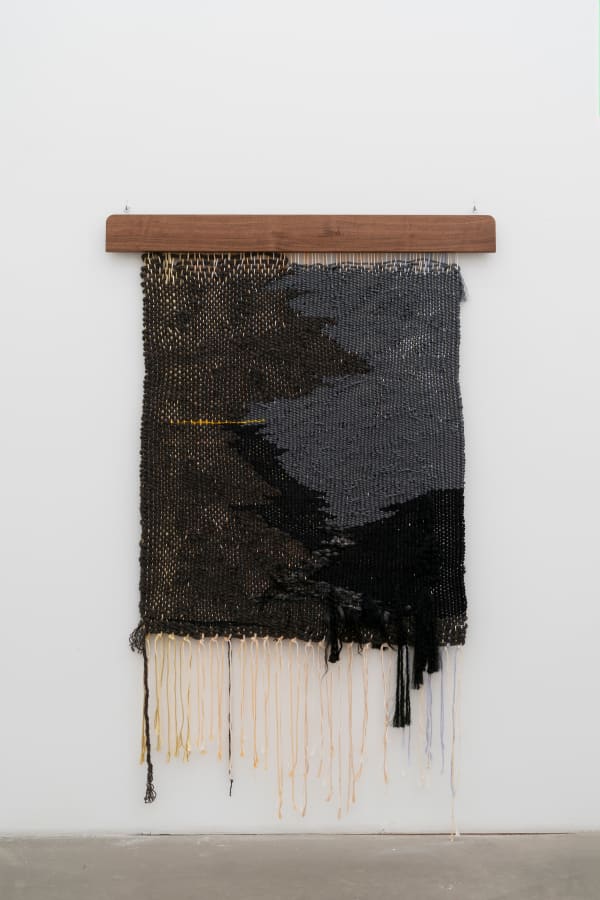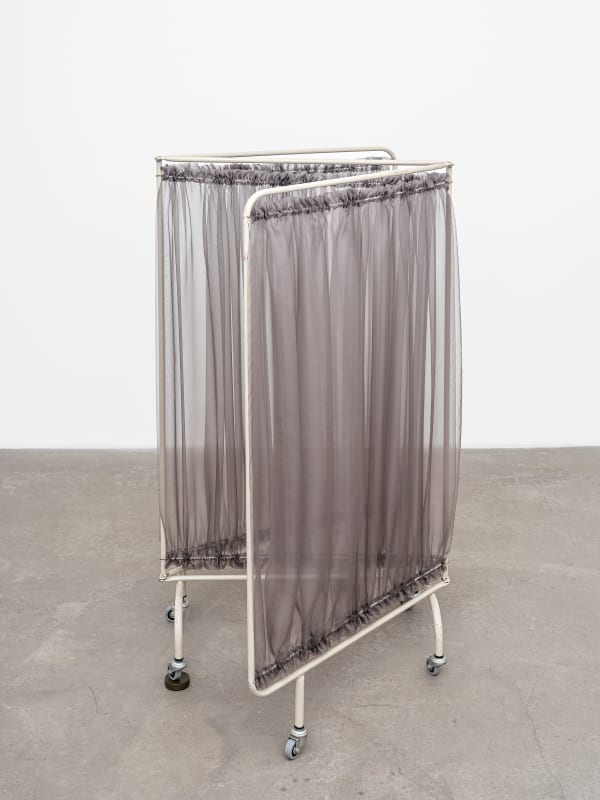ANN CATHRIN NOVEMBER HØIBO: "VIRVEL FOR VIRVEL"
ANN CATHRIN NOVEMBER HØIBO
VIRVEL FOR VIRVEL
23.08.-21.09.2024 / PREVIEW: FRIDAY 23.08.2024 / 19.00 - 21.00
-----
“Many have spoken of the Real as what erupts in trauma – the sudden uncanny presence of the sheer materiality and mortality of the body.”1
Bodies are ghostly present. Thread by thread, Ann Cathrin November Høibo’s tapestries are laboriously handwoven with a fork; a tool usually put repeatedly in and out of the mouth. Intuition is translated into abstract, tactile landscapes in materials that are made for, and sometimes from, bodies: matte cotton, luminous rayon, raw wool, protective gauze. Seeing is secondary and there is no editing. Clarice Lispector wrote “I am not an intellectual, I write with my body. And what I write is a moist fog.”2 November Høibo seems to embody a similar attitude in her art-making.
Over the past 20 years, the artist has been in the possession of a massive roll of gauze bandage. Predominantly used in medical dressing, gauze is a thin, white fabric with a loose open weave which allows moisture and air to pass through. Etymologically, gauze is likely to come from the name of the city Gaza, Palestine, where the fabric is believed to have originated in the 16th century. Gaza also means “strength” in Ancient Semitic languages. Other possible origins of the word are the French equivalent gaze, Persian Gazi; “thin fabric”, or Arabic gazz; “silk”. In English, another meaning of gauze is “haze”; a lack of transparency of the air; a cloudy appearance in liquid; or vagueness of the mind.3 One can say that something is gauzelike or gauzily. A synonym to these is sheer – meaning both transparent and utter: “having no exceptions or restrictions”.4
For her exhibition Virvel for virvel, November Høibo has produced two new series of works – one in which two tapestries are woven with predominantly gauze bandage. When the transparent fabric is woven thickly and tightly on wool warp, it becomes compact and opaque: a white, almost luminescent mass. Here and there, pieces of fabric protrude from the textured surface, reminiscent of vulnerable veils. It is as if this contrast broaches the one between the material’s strength and healing properties and the fragility of the wounded bodies which it is intended to heal, and whose absence is palpable. Violent images tend to stick. Gauze means Gaza, is from Gaza. In the bright lights of the gallery space, the fabrics’ whiteness and cleanliness is almost staggering – in its beauty and poeticism, the woven textile underscores sharply the extreme discrepancies this material surplus points to. In our house, the gauze is not needed for its intended use.
Løpere (2019) appears: a sculpture consisting of a screen wall with a delicate, transparent silk organza, which has one foot standing on a snus box. Crookedly positioned, it appears human-like and confers the artists’ continuous interest in questions around materials, consumption, the body and value. Placed together with the mentioned tapestries, whose material was sourced from local medical supply manufacturer Snøgg nearby Kristiansand – November Høibo’s hometown – these questions seem to expand into medical infrastructure and a rapidly growing industrial-military complex.
Six new tapestries bear abstract, painterly motives in earthly colors: variations of yellow, beige and brown, greens, blues and darker greys. Woven in her home in Kristiansand, behind the almost, yet not quite, discernable landscape-like formations, these local surroundings appear as important influences – the shifting light between sunrise and sunset, the sea and maritime life, the forest and the rocks of Southern Norway. The works’ mixture of matte cotton and shining rayon fashions a potential lively play with light, placed as they are in the gallery’s window front space. Were a ray of sunlight to hit the windows, some tapestries turn almost golden. Simultaneously, a tension occurs between the materials’ connections to highly polluting industries and the hymn to nature created on the organic, rough and textured surfaces. As such, our current times’ catastrophic cruelty and ignorant destruction looms over the exhibition, and subtly, November Høibo’s work insist on art’s and textile’s political potential.
- Live Drønen
1 Jamieson Webster, Disorganization & Sex (Divided Publishing, 2022), 26.
2 Clarice Lispector, The Hour of the Star, trans. Benjamin Moser (Penguin Press, 2014), 8.
3 Merriam Webster. 19.08.2024. https://www.merriam-webster.com/dictionary/haze
4 Merriam Webster. 19.08.2024. https://www.merriam-webster.com/thesaurus/sheer
-----
Ann Cathrin November Høibo lives and works in Kristiansand, Norway. She received her education at The Art Academy in Oslo and Städelschule in Frankfurt am Main. Recent solo exhibitions include Kristiansand Kunsthall and Sørlandets Kunstmuseum, Kristiansand; Kunstnerforbundet, Oslo; Carl Freedman Gallery, London; and Drei, Colgone.
-----










